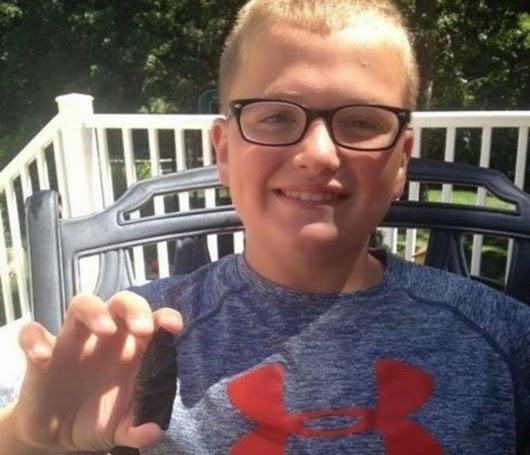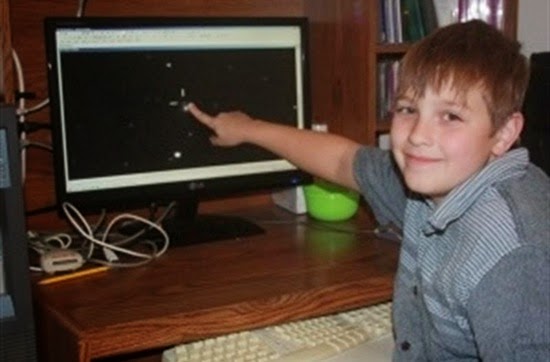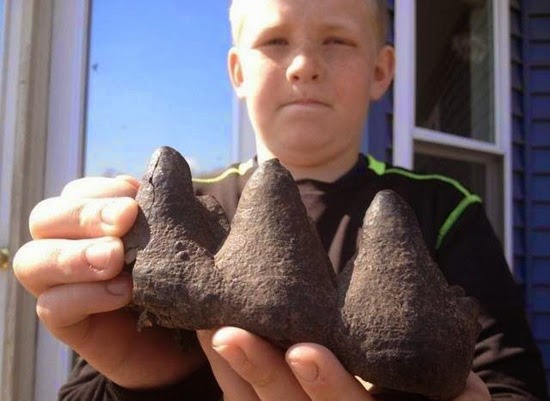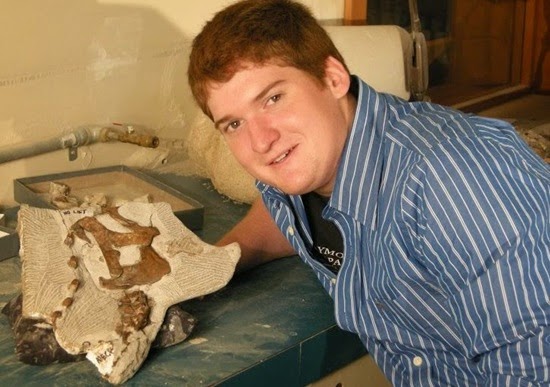
Palaeontologist, biologist, astronomer: These might sound like job titles for grown-ups, but adults aren't the only ones who fill these important roles.
Children - with their endless curiosity and tendency to wander off the beaten track - are also engaged in quite a bit of scientific research and exploration. From spotting a supernova to digging up dinosaur bones, here are seven discoveries made by kids.
1. 10,000-year-old souvenir
Noah Cordle with the arrowhead he discovered. Photo: Cordle Family/AP via NJ.com.
In August, one kid's summer vacation turned into an unexpected history lesson when he unearthed a 10,000-year-old arrowhead in the sand at a New Jersey beach. [10 Science Discoveries to Be Thankful For]
Ten-year-old Noah Cordle discovered the rare artefact while playing at the edge of the surf, according to the Associated Press. His family contacted the Archaeological Society of New Jersey to inquire about what the boy had found. The president of the society, Greg Lattanzi, told the family the artefact was a stone arrow point likely used by pre-tribal Native Americans, or Paleo-Indians, who passed through the area 8,000 to 11,000 years ago while hunting fish and birds.
Discoveries of such arrowheads in the state are rare, Lattanzi told the Asbury Park Press. The New Jersey State Museum in Trenton houses about two dozen of the artefacts, but most were unearthed by professionals at archaeological digs, Lattanzi said.
2. Stargazing surprise
Nathan Gray points to his supernova find. Photo: CBC News.
In November 2013, a 10-year-old in Canada became the youngest person ever to discover a supernova, or exploding star, according to a CBC News report.
Nathan Gray spotted the supernova with a bit of help from his father and Dave Lane, owner and operator of Abbey Ridge Conservatory in Stillwater Lake, Nova Scotia.
The young astronomer told CBC News that he had been watching the night sky for six months in the hope of observing a stellar explosion. He said the supernova looked like a "blinking star" and that he was both "really excited and kind of happy" to have made the discovery.
3. Fun with flies
Simon Kashchock-Marenda (right). Photo: NewsTribune photo/Scott Anderson.
Need proof that middle-school science projects beget scientific discoveries? Meet Simon Kashchock-Marenda, a student in the United States whose unique experiment inspired a study by scientists at Drexel University in Philadelphia.
Kashchock-Marenda was interested in finding out how artificial sweeteners, such as Sweet'N Low and Equal, affect fruit flies. He fed groups of the flies different sweeteners, one of which was Truvia, an artificial sweetener containing a sugar alcohol called erythritol. The flies that fed on the Truvia died within six days, leading the budding scientist to hypothesize that, for fruit flies, Truvia isn't a healthier alternative to sugar.
With help from his father, a professor of biology at Drexel, the middle-school student repeated the experiment under laboratory conditions and observed similar results. Drexel researchers later concluded that the erythritol in Truvia has a toxic effect on the flies, leading them to explore whether erythritol could one day be used as a human-safe insecticide.
4. Toothy tumble
Phillip Stoll with the Mastodon tooth he discovered. Photo: Will Kangas/Lansing State Journal.
In April 2014, a boy in Michigan discovered something very cool to bring in for show and tell - a 10,000-year-old mastodon tooth. Nine-year-old Phillip Stoll tripped over the tooth while walking barefoot in a creek bed near his home, according to CNN.
The tooth was brown, about 8 inches (20 centimetres) long and had six distinct peaks. Despite its abnormally large size, Stoll told CNN he recognized the object as a tooth right away. He and his mother contacted James Harding, a herpetologist (reptile and amphibian expert) at nearby Michigan State University, to find out more about the origins of the strange-looking tooth.
Harding informed the young explorer that he had discovered the tooth of a mastodon, a prehistoric relative of today's elephant, CNN reports.
5. Fungi find
Elan Filler. Photo: Los Angeles County Science Fair.
For over a decade, people in Southern California have been getting sick (and in some cases dying) after coming into contact with a fungus called Cryptococcus gattii. But for years, the scientists who study C. gattii weren't able to determine exactly where people were meeting up with this deadly fungus, according to a recent report by NPR.
Enter Elan Filler, a seventh-grader in search of a cool science fair project. Her father, an infectious disease specialist, recommended she take up the challenge of finding out where C. gattii was hiding out. Filler started investigating and ultimately identified at least three trees infected with the fungus in the greater Los Angeles area.
She shared her discovery with researchers at Duke University in North Carolina. Her findings were part of a study published Aug. 21, 2014, in the journal PLOS Pathogens.
6. Dino discovery
Kevin Terris with his discovery. Photo: NBC News.
It's fitting that the youngest duck-billed dinosaur ever discovered was unearthed by a kid, not a wizened palaeontologist. In 2009, Kevin Terris was conducting palaeontology fieldwork for a high-school class when he discovered some baby dino bones sticking out from under a boulder in Utah's Grand Staircase-Escalante National Monument. [See Photos of the Baby Dinosaur Discovery]
With help from Andrew Farke, a palaeontologist and curator at Raymond M. Alf Museum of Palaeontology in Claremont, California, Terris and his classmates unearthed the remains of a Parasaurolophus, a Cretaceous-era herbivore, which roamed the Earth about 75 million years ago.
Terris' discovery is the smallest, youngest and most complete duck-billed Parasaurolophus ever found.
7. Kiddy archaeology
Matthew Berger with his discovery. Photo: Lee R. Berger/Wikimedia Commons.
In 2008, 9-year-old Matthew Berger was spending a day with his archaeologist dad at a dig near Johannesburg, South Africa, when he discovered what were later identified as the remains of one of mankind's ancient ancestors, Australopithecus sediba. [8 Grisly Archaeological Discoveries]
The 2 million-year-old bones were located just outside the area that the boy's father, Lee Berger, was canvassing for fossils. In an interview with Live Science in 2010, the elder Berger said that his son found the remains after running off the site to do some exploring on his own.
Researchers later concluded the young explorer had discovered bones belonging to a previously unknown ancient hominid, or human ancestor. Berger's father and his team later dug up two skeletons from the site, one an adult female, the other a juvenile male.
To keep the spirit of kid-fuelled discovery alive, children in South Africa were invited to help name the juvenile male skeleton. The ancient kid is now known as Karabo, a Setswana word that means "answer."







No comments:
Post a Comment
Please adhere to proper blog etiquette when posting your comments. This blog owner will exercise his absolution discretion in allowing or rejecting any comments that are deemed seditious, defamatory, libelous, racist, vulgar, insulting, and other remarks that exhibit similar characteristics. If you insist on using anonymous comments, please write your name or other IDs at the end of your message.